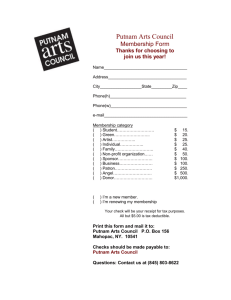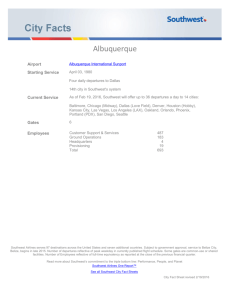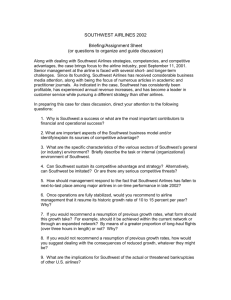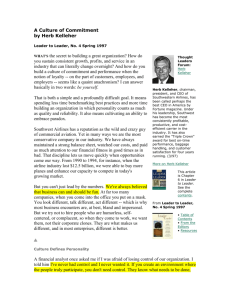Howard Putnam leadership in turbulent times
advertisement
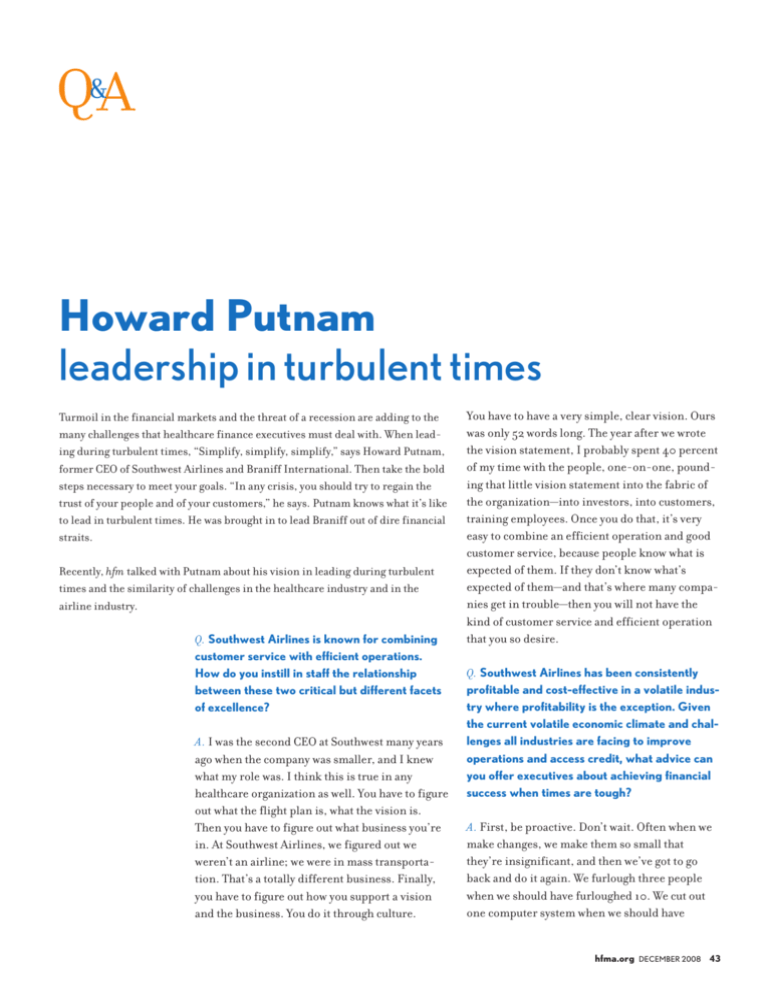
Howard Putnam leadership in turbulent times Turmoil in the financial markets and the threat of a recession are adding to the many challenges that healthcare finance executives must deal with. When leading during turbulent times, “Simplify, simplify, simplify,” says Howard Putnam, former CEO of Southwest Airlines and Braniff International. Then take the bold steps necessary to meet your goals. “In any crisis, you should try to regain the trust of your people and of your customers,” he says. Putnam knows what it’s like to lead in turbulent times. He was brought in to lead Braniff out of dire financial straits. Recently, hfm talked with Putnam about his vision in leading during turbulent times and the similarity of challenges in the healthcare industry and in the airline industry. Q. Southwest Airlines is known for combining customer service with efficient operations. How do you instill in staff the relationship between these two critical but different facets of excellence? A. I was the second CEO at Southwest many years ago when the company was smaller, and I knew what my role was. I think this is true in any healthcare organization as well. You have to figure out what the flight plan is, what the vision is. Then you have to figure out what business you’re in. At Southwest Airlines, we figured out we weren’t an airline; we were in mass transportation. That’s a totally different business. Finally, you have to figure out how you support a vision and the business. You do it through culture. You have to have a very simple, clear vision. Ours was only 52 words long. The year after we wrote the vision statement, I probably spent 40 percent of my time with the people, one-on-one, pounding that little vision statement into the fabric of the organization—into investors, into customers, training employees. Once you do that, it’s very easy to combine an efficient operation and good customer service, because people know what is expected of them. If they don’t know what’s expected of them—and that’s where many companies get in trouble—then you will not have the kind of customer service and efficient operation that you so desire. Q. Southwest Airlines has been consistently profitable and cost-effective in a volatile industry where profitability is the exception. Given the current volatile economic climate and challenges all industries are facing to improve operations and access credit, what advice can you offer executives about achieving financial success when times are tough? A. First, be proactive. Don’t wait. Often when we make changes, we make them so small that they’re insignificant, and then we’ve got to go back and do it again. We furlough three people when we should have furloughed 10. We cut out one computer system when we should have hfma.org DECEMBER 2008 43 Q&A combined two and thrown out three others. We don’t take the big steps in tough times until it’s sometimes too late. Second, simplify, simplify, simplify. I always felt one of my responsibilities as CEO was to take the complexity out and make it as simple as possible. What better time to do that than when you’re in turbulent times? HOWARD PUTNAM AT HFMA’S EXECUTIVE SUMMIT Howard Putnam will discuss leadership in turbulent times at HFMA’s 2009 Executive Summit March 8-9 in Phoenix. For information and to register, visit www.hfma.org/ executivesummit or call (800) 252-4362, ext. 2. The other challenge people have in turbulent times is they start to diversify, thinking they should try a different business. They might think instead of being heart surgeons, they could remove kidneys. My advice would be diversify only when you have the skill sets to do it. Don’t spend any money starting new businesses. Just try to cut the costs as quickly as you can and stay in what you know how to do best. Q. You led the restructuring of Braniff International, saving the company from financial ruin. Many healthcare organizations also struggle with financial challenges as payments decline and costs increase. What are some leadership strategies that healthcare organization executives can employ when a turnaround is necessary? A. First, there needs to be a flight plan. When I got to Braniff, I found that the company was in worse financial shape than I had been led to believe. We had only 10 days of cash. The due diligence that we performed showed that there was $175 million more in cash on the books than actually existed. What a shock that was after I had resigned from Southwest and found out I had taken on a billion-dollar corporation that had only 10 days of cash. There was no flight plan, no direction. Morale was awful. And, of course, there was no cash. The first thing we did was to come up with a flight plan that was very, very concise and simple. We didn’t spend a lot of time going out and forming committees and studying and so forth. You don’t have time when you’ve got 10 days of cash. You make a decision, and then you get everybody 44 DECEMBER 2008 healthcare financial management together and say, “This is the direction we’re going. Now is your opportunity to get off if you don’t want to stay on board, because this is the direction we’re going and this is going to be very stressful. It’s going to be very turbulent.” You have to present the facts in plain language that shocks the employees to reality. What happens with most organizations is the employees don’t want to hear bad news, the executives don’t want to deliver bad news, and therefore a lot of time is wasted and more cash just goes down the drain. In the case of Braniff, once we had the flight plan, I needed to start making some changes in the organization. Rather than start working on the front line, where we really needed the help in customer service—and where you really need the help in a healthcare organization—I thought, “I’ve got to fix my own bureaucracy first.” So I cleaned out the executive suite. Braniff had more than 50 vice presidents. I took out 30 of those and all of their staffs in the first 60 days and flattened the organization. They had eight or nine levels of management. We took out entire levels. That would be my advice also in health care: Don’t go in and just pick one job here and one job there. Take out an entire level of management in the organization and bureaucracy. Let the people on the front line see that you mean business. Look at the financial organizations that are going bankrupt on Wall Street. Their CEOs and top people are taking gigantic bonuses. That is absolutely absurd. You’ll never gain trust doing that. In any crisis, you should try to regain the trust of your people and then of your customers. So at Braniff we leaned down the executive suite first. I took out some 700 people in 60 days. Then we began to make process changes and productivity changes to improve the service in the front. We kept alive for seven months before we just ran out of cash and had to put the company into Chapter 11 to reorganize it. But we had the greatest morale I’ve ever seen. And it’s because the people finally had some Q&A leadership that they trusted. They knew I wasn’t there to take and break the bank for myself. I was in it as deep as they were to try to save everybody’s jobs. Q. Southwest Airlines has been recognized for its approach to talent management. Could you tell us your philosophy about developing new leaders? A. We had a saying at Southwest, and they still do: “We hire attitudes; we develop their skills.” Obviously, if you’re going to bring a surgeon on staff, you would hope he or she already had some skills before you brought them on, but the idea was to hire people who match your culture. That again is why it is so important that the little vision/mission statement is clear. We developed a brand at Southwest so that people understood before they hired on that this is a mass transportation company. They have only one kind of airplane. Everybody really has to work hard here, but they have a lot of fun. And they keep the fares low so they can get people out of the automobile, out of their living room, and about Howard Putnam increase the size of the market. If we can make all that happen, we have a profit-sharing plan as well. And somewhere down the road, we will benefit from that. If that doesn’t fit your makeup to work in that kind of an organization, we would simply say, “Don’t apply here. We’re not a fit for you.” Often we rely too much on job descriptions and education when we basically need somebody with a good attitude who really wants to be a part of the organization. That was the key factor. Because the organization was very flat with very few levels of management, we had to come up with creative ways to give people experience so they could become managers, vice presidents, etc., so we created SWAT teams. If we had a problem in a city somewhere, we would pick a pilot, a flight attendant, a ticket agent, a sales person, and put them together as a team and tell them, “Okay, folks, we want you to go to Los Angeles. You’ve got a week to figure out what’s going on with baggage handling there, whatever the problem was, and come back and tell us what we need to do.” You quickly got to see what kinds of thinkers you had on the front line. This gave Howard Putnam has held executive positions with United Airlines, Southwest Airlines, and Braniff International. Raised on an Iowa farm, he learned to fly out of a pasture in his father’s J-3 Piper Cub. He entered the airline business at age 17 as a baggage handler for Capital Airlines at Midway Airport in Chicago. Capital was soon merged into United. Putnam held 13 positions in sales, services, and staff assignments in several cities before being named group vice president of marketing in 1976. In 1978, Putnam was named president and CEO of Southwest Airlines in Dallas. While at Southwest, he and his team tripled revenues and profitability in three years. They also successfully guided Southwest through airline deregulation. Southwest was the first air carrier to order the Boeing 737-300, which later became the largest-selling aircraft ever for Boeing. Putnam led the visioning process at Southwest and the further development of the airline’s fun culture and excellent customer service. In 1981, Putnam was recruited to be CEO of Braniff International and save and/or restructure the financially failing airline. He was the first airline CEO to successfully take a major carrier into, through, and out of Chapter 11 bankruptcy. Braniff flew again in 1984. He wrote the book The Winds of Turbulence: A CEO’s Reflections on Surviving and Thriving on the CuttingEdge of Corporate Crisis. Harvard University wrote a case study, Braniff International: The Ethics of Bankruptcy, about Putnam’s experiences at Braniff. Putnam also has been an entrepreneur, serving as chairman of a startup investment company and two small manufacturing and distribution companies. hfma.org DECEMBER 2008 45 Q&A READ MORE ABOUT LEADING IN TURBULENT TIMES Read more about Howard Putnam’s views on leading during turbulent times at www.howardputnam.com. growth opportunities to a lot of people who today are senior vice presidents with the company. Q. Hospitals function within complex, often illogical regulations and practices that sometimes hamper the ability to fulfill the mission of highquality care. Hospitals also have labor challenges, including union relations. What major lessons might hospital executives learn from your experience in a similarly complex industry? A. First, Southwest Airlines is totally unionized and has been for more than 30 years, which surprises a lot of people, because they don’t believe you can have good customer service and good attitudes with unions, but you can. We worked our way through the unions to the families. Every quarter, we sent a letter to every family at home telling them about the profitability of the company. And if we were on target, they all got a small check in the mail. I wrote the letter to the family. It wasn’t written by PR staff or anyone else. I would personally sign 100 to 200 letters each quarter and write little notes at the bottom. We did this to bring the family into it so that they knew what we were all up against. I believe you can have unions and have good customer relations and good employee relations. But it has to start with the CEO and the board of directors. They have to be committed 24/7, and not say their people are their most important The CEO and the board must be committed 24/7, and not say their people are their most important asset without believing it. asset without believing it. We believed it at Southwest, and they still do today. There was a strike when I was there. People don’t believe that Southwest Airlines could ever have had a strike, but we had one with the maintenance organization. But we had a plan and we kept operating. They came back after six days and threw that union out and formed another one later on. Again, it was the trust factor. The people saw that management had strong leadership. They saw that management was not going to kowtow to anybody, but that we also believed that we were one big family and everybody had to be involved. Complexity? Yes, we had all the regulation, weather, safety. There are so many analogies between health care and commercial airlines it’s amazing. They are both very tough businesses, but they both are absolutely essential to our life, our lifestyle, and our economy. Reprinted from the December 2008 issue of hfm magazine. Copyright 2008 by Healthcare Financial Management Association, Two Westbrook Corporate Center, Suite 700, Westchester, IL 60154. For more information, call 1-800 -252-HFMA or visit www.hfma.org. 46 DECEMBER 2008 healthcare financial management

